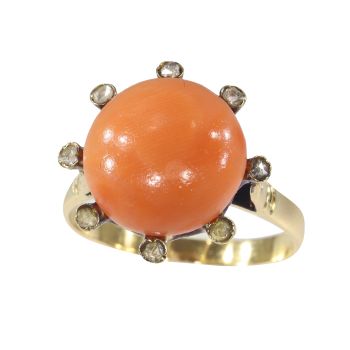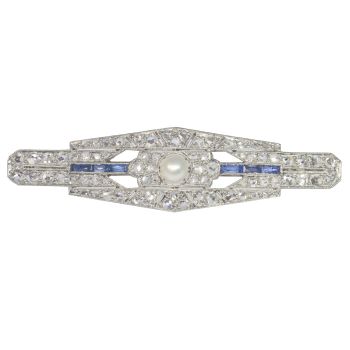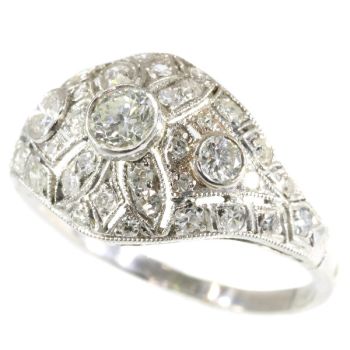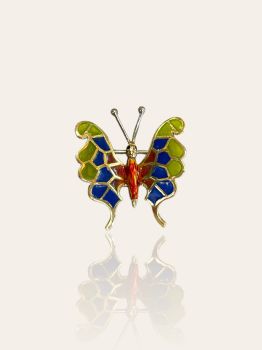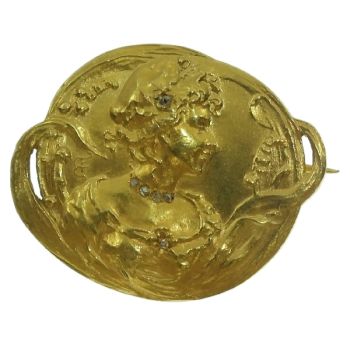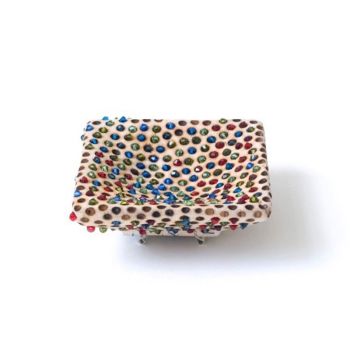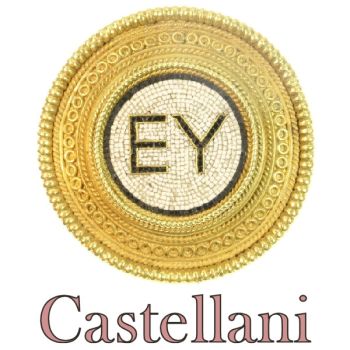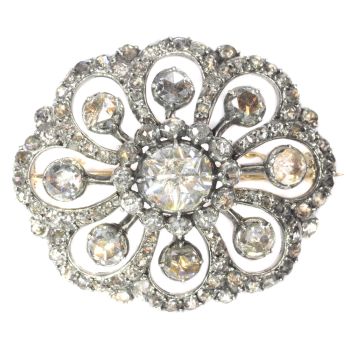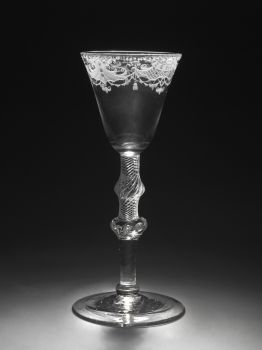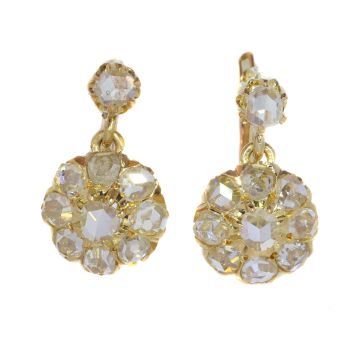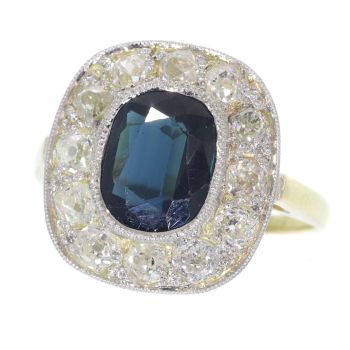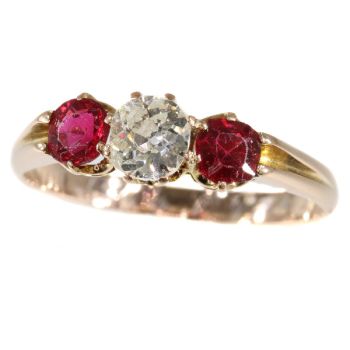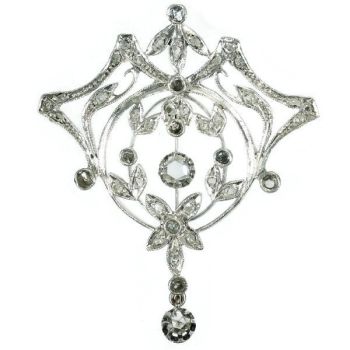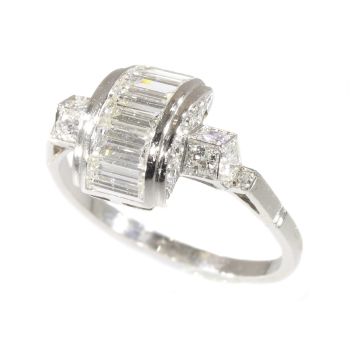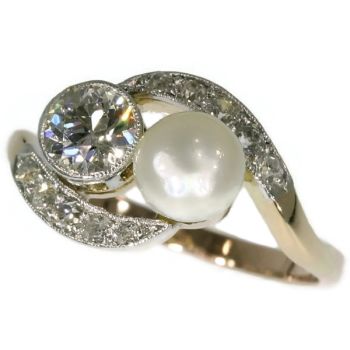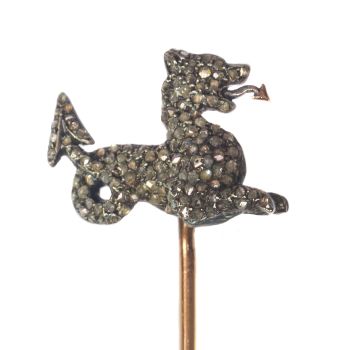French Art Deco so-called tutti frutti brooch with diamond emerald sapphire 1920
Unknown artist
DiamondEmeraldSapphireGemstone
€ 14.000
Adin Fine Antique Jewellery
- About the artwork
Antique jewelry object group: brooch
Condition: very good condition
- (more info on our condition scale)
Country of origin:France
Style: Art Deco - Art Deco is an eclectic artistic and design style which had its origins in Paris in the first decades of the 20th century. The style originated in the 1920s and continued to be employed until after World War II. The term "art deco" first sawwide use after an exhibition in 1966, referring to the 1925 Exposition Internationale des Arts Décoratifs et Industriels Modernes that was the culmination of high-end style modern in Paris. Led by the best designers in the decorative arts such asfashion, and interior design, Art Deco affected all areas of design throughout the 1920s and 1930s, including architecture and industrial design, as well as the visual arts such as painting, the graphic arts and film. At the time, this style was seen aselegant, glamorous, functional and modern.
- See also: Art Decoor more info on styles
Style specifics: Abstract motives and geometrical forms are quite typical for the Art Deco period. Art Deco moved away from the soft pastels and organic forms of its style predecessor, Art Nouveau, and embraced influences from many different styles and movements of the early 20th century, including Neoclassical, Constructivism, Cubism, Modernism, and Futurism. Its popularity peaked in Europe during the Roaring Twenties and continued strongly in the United States through the 1930s. Although many design movements havepolitical or philosophical roots or intentions, Art Deco was purely decorative.
Period: ca. 1920
- (events & facts of this era, poetry of this era, fashion of this era)
Source of inspiration: Mother Nature
Material: The brooch is in platinum and the pin in 18K white gold (as normal in that era and hallmarked as such)
- (more info on precious metals)
Extra information: Tutti Frutti - Jewelry like this, set with brightly colored gemstones polished as leaves are called "Tutti Frutti jewelry". The first Tutti Frutti piece was a necklace commissioned by Queen Alexandra and designed by Pierre Cartier in 1901. Tutti Fruttijewel designs are considered to be a perfect mix of East and West because they are made up of brightly colored gemstones (like sapphires, rubies and emeralds) carved using Indian techniques and set in French platinum and diamond mountings.The stylebecame extremely popular during the 1920's, but it wasn't named 'Tutti Frutti' until 1970.
Diamonds:42 old brilliant cut diamonds with a total estimated weight of approx. 2.94 crt. (approximate color and clarity G/J, vs/si)and ten smaller old brilliant cut diamonds with a total estimated weight of approx. 0.15 crt.
Note: All diamond weights, color grades and clarity are approximate since the stones were not removed from their mounts to preserve the integrity of the setting.
Total diamond weight: approx. 3.09 crt.
Precious stones: Four sapphires andthree emeralds, all polished and engraved as leaves.
- (more info on precious stones)
Birthstones: Diamond is the birthstone (or month stone) for April, sapphire for September and emerald for May.
- (more info on birthstones)
Makers mark: The makers hallmark is eligible although we think we recognize the letter C as part of this hallmark.
Hallmarks: The French control marks representing an eagle’s head (that was in use in France from about 1838) next to the dog's head which is the official French hallmark for jewelry containing or made of platinum and that has been used since 1912..
- (more info on hallmarks)
Dimensions: 2,88 cm (1,13 inch) x 2,78 cm (1,09 inch)
Weight: 9,30 gram (5,98 dwt)
Reference Nº: 16123-0060
Copyright photography: Adin, fine antique jewelry
- About the artist
It might happen that an artist or maker is unknown.
Some works are not to be determined by whom it is made or it is made by (a group of) craftsmen. Examples are statues from the Ancient Time, furniture, mirroirs, or signatures that are not clear or readible but as well some works are not signed at all.
As well you can find the following description:
•“Attributed to ….” In their opinion probably a work by the artist, at least in part
•“Studio of ….” or “Workshop of” In their opinion a work executed in the studio or workshop of the artist, possibly under his supervision
•“Circle of ….” In their opinion a work of the period of the artist showing his influence, closely associated with the artist but not necessarily his pupil
•“Style of ….” or “Follower of ….” In their opinion a work executed in the artist’s style but not necessarily by a pupil; may be contemporary or nearly contemporary
•“Manner of ….” In their opinion a work in the style of the artist but of a later date
•“After ….” In their opinion a copy (of any date) of a work of the artist
•“Signed…”, “Dated….” or “Inscribed” In their opinion the work has been signed/dated/inscribed by the artist. The addition of a question mark indicates an element of doubt
•"With signature ….”, “With date ….”, “With inscription….” or “Bears signature/date/inscription” in their opinion the signature/ date/ inscription has been added by someone other than the artist
Are you interested in buying this artwork?
Related artworks
- 1 - 4 / 12
- 1 - 4 / 24
- 1 - 4 / 24
Artista Desconhecido
Uma rara filigrana a taça retortoli1550 - 1600
Preço em pedidoPeter Korf de Gidts - Antiquairs
1 - 4 / 24- 1 - 4 / 24
Artista Desconhecido
Enchanting 1870s Vintage Fly Brooch: Victorian Elegance in Gold1870
€ 4.600Adin Fine Antique Jewellery
 Com curadoria de
Com curadoria deDanny Bree
1 - 4 / 12















